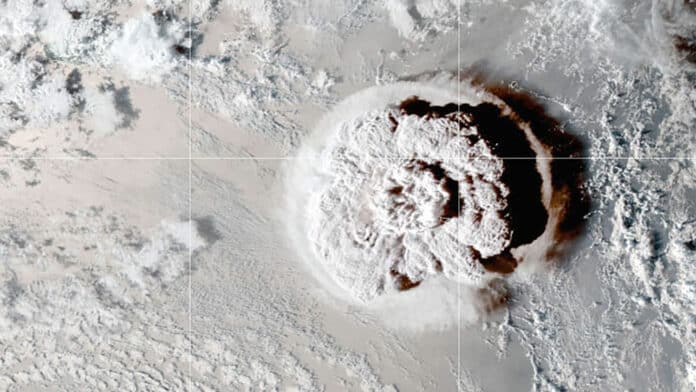After staying relatively inactive since 2014, the Hunga Tonga–Hunga Haʻapai volcano erupted on Jan. 2022. The eruption sent atmospheric shock waves, sonic booms, and tsunami waves worldwide.
In a recent study, a team from the University of Hawaiʻi at Mānoa and Oregon State University revealed that the bloom of microscopic marine life covered an area nearly 40 times the size of the island of Oʻahu, Hawaiʻi within 48 hours after the eruption.
Scientists looked at various satellite images, including true color, red and infrared radiation emission, and light reflected at the ocean’s surface. They concluded that the deposition of volcanic ash was probably the primary source of nutrients causing phytoplankton growth.
Benedetto Barone, a lead author of the study and research oceanographer at the Center for Microbial Oceanography: Research and Education (C-MORE) in SOEST, said, “Even though the Hunga Tonga-Hunga Haʻapai eruption was submarine, a large plume of ash reached a height of tens of kilometers into the atmosphere. The ash fallout supplied nutrients that stimulated the growth of phytoplankton, which reached concentrations well beyond the typical values observed in the region.”
Phytoplanktons are tiny photosynthetic organisms that produce oxygen and serve as the base of the marine food web.
Dave Karl, study co-author and director of C-MOREsaid, “We were impressed to observe the large region with high chlorophyll concentrations within such a short time after the eruption. This shows how quickly the ecosystem can respond to nutrient fertilization.”
Ken Rubin, study co-author and volcanologist in the SOEST Department of Earth Sciences, said, “A casual observer might see seemingly very different parts of the environment—in this case, a volcano producing a large eruption and a major shift in the ecology of the oceans nearby. However, our observations illustrate the broad interconnectedness and interdependence of different aspects of the environment, perhaps even indicating an under-appreciated link between volcanism and shallow marine ecosystems globally.”
Barone said, “When I heard of the Tonga eruption, it was fairly straightforward to modify the computer code that I had written to analyze the satellite measurements around Hawaiʻi to determine the impact of the Tonga eruption on the nearby ocean ecosystem. From the first moment of seeing the results of the analysis, it was clear that there had been a fast phytoplankton response in a large region.”
Journal Reference:
- B. Barone, R. M. Letelier, K. H. Rubin, D. M. Karl. Satellite Detection of a Massive Phytoplankton Bloom Following the 2022 Submarine Eruption of the Hunga Tonga-Hunga Haʻapai Volcano. Geophysical Research Letters. DOI: 10.1029/2022GL099293
